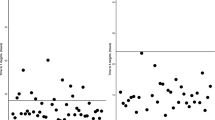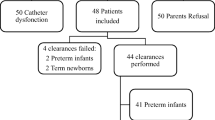Abstract
We evaluated the relationship between gentamicin pharmacokinetics and glomerular filtration rate in newborn infants to estimate the appropriate interval of administration in neonates with renal insufficiency. Gentamicin half-life (Gt 1/2) could be predicted from plasma creatinine concentration (Pcr) (r=0.78); the prediction was minimally but significantly increased (r=0.81) by adding postconceptional age to a multiple regression analysis. Infants with a postconceptional age of 29 weeks or more and a Pcr of 1 mg/dl or more had significantly greater trough and peak gentamicin levels than those with a Pcr less than 1 mg/dl. If gentamicin is indicated in a patient with renal insufficiency, the interval of administration should be 2–3 Gt 1/2, which can be estimated from Pcr (Gt 1/2=2.0+7.7 Pcr). The interval can then be adjusted according to peak and trough gentamicin levels.
Similar content being viewed by others
References
Zarowitz BJM, Wynn RJ, Clarke DF, Buckwald S, Szefler SJ (1982) High gentamicin trough concentrations in neonates of less than 28 weeks of gestational age. Dev Pharmacol Ther 5: 68–75
Sirinavin S, McCracken GH, Nelson JG (1980) Determining gentamicin dosage in infants and children in renal failure. J Pediatr 96: 331–334
Ksaik JW, Jenkins S, Leuschen MP, Nelson RM (1985) Postconceptional age and gentamicin half-life. J Pediatr 106: 502–505
Reimche LD, Rooney ME, Hindmarsh KW, Sankaran K (1987) An evaluation of gentamicin dosing according to renal function in neonates with suspected spesis. Am J Perinatol 4: 262–265
Szefler SJ, Wynn RJ, Clarke DF (1980) Relationship of gentamicin serum concentrations to gestational age in preterm and term neonates. J Pediatr 97: 312–315
Charlton CK, Needelman H, Thomas RW, Kortas K (1986) Gentamicin dosage recommendations for neonates based on half-life predictions from birthweight. Am J Perinatol 3: 28–32
Kildoo C, Modanlou HD, Komatsu G, Harralson A, Hodding J (1984) Developmental pattern of gentamicin kinetics in very low birth weight (VLBW) sick infants. Dev Pharmacol Ther 7: 345–356
Lugo EJ, Smith FR, Rawlings JS, Bass JW (1986) Optimal gentamicin therapy in premature neonates: a dosage regimen adjusted for gestational age. J perinatol 6: 337–341
Roberts RJ (1984) Drug therapy in infants. Pharmacologic principles and clinical experience. Saunders, Philadelphia, pp 61–70
Hindmarsh KW, Nation RL, Williams GL, French JN (1983) Pharmacokinetics of gentamicin in very low birth weight preterm infants. Eur J Clin Pharmacol 24: 649–653
Zager RA, Sharma HM, Johannes GA (1983) Gentamicin increases renal susceptibility to an acute ischemic insult. J Lab Clin Med 101 670–678
Spiegel DM, Shanley PF, Molitoris BA (1990) Mild ischemia predisposes the S3 segment to gentamicin toxicity. Kidney Int 38: 459–464
McCracken GH, West NR, Horton LJ (1971) Urinary excretion of gentamicin in the neonatal period. J Infect Dis 123: 257–262
McCracken GH, Chrane DF, Thomas ML (1971) Pharmacologic evaluation of gentamicin in newborn infants. J Infect Dis 124: S214-S223
Riviere JE (1982) Limitations on the physiologic interpretation of aminoglycoside body clearance derived from pharmacokinetic studies. Res Commun Chem Pathol Pharmacol 38: 31–42
Koren G, James A, Perlman M (1985) A simple method for the estimation of glomerular filtration rate by gentamicin pharmacokinetics during routine monitoring in the newborn. Clin Pharmacol Ther 38: 680–685
Keyes PS, Johnson CK, Rawlins T (1989) Predictors of trough serum gentamicin concentrations in neonates. Am J Dis Child 143: 1419–1423
Phaneuf D, Franke E, Neu HC (1980) Rapid, reproducible immunoassay for gentamicin. J Clin Microbiol 11: 266–269
Benet LZ, Sheiner LB, Sande MA, Mandell GL (1985) In: Goodman LS, Gilman AG (eds) The pharmacological basis of therapeutics. MacMillan, New York, pp 3–34 and 1150–1169
Clermont MJ, Brion L, Schwartz GJ (1986) Reliability of plasma creatinine measurement in children. Clin Pediatr (Phila) 25: 569–572
Schwartz GJ, Feld LG, Langford DJ (1984) A simple estimate of glomerular filtration rate in full term infants during the first year of life. J Pediatr 104: 849–854
Brion L, Fleischman AR, McCarton C, Schwartz GJ (1986) A simple estimate of glomerular filtration rate in low birth weight infants during the first year of life: non invasive assessment of body composition and growth. J Pediatr 109: 698–707
Brion L, Fleischman AR, Schwartz GJ (1985) Evaluation of four length-weight formulas for estimating body surface area in newborn infants. J Pediatr 107: 801–803
Brion LP (1990) Use of a Lotus 1-2-3 spreadsheet to plot the confidence and the prediction intervals in linear regression analysis. Comput Biol Med 20: 129–134
Miranda JC, Schimmel MM, James LS, Spinelli W, Rosen TS (1985) Gentamicin kinetics in the neonate. Pediatr Pharmacol 5: 57–61
Riff L, Schauff V (1982) Use of aminoglycosides in the neonate. Semin Perinatol 6: 155–165
Edgren B, Karna P, Sciamanna D, Dolanski E (1984) Gentamicin dosing in the newborn. Use of a one-compartment open pharmacokinetic model to individualize dozing. Dev Pharmacol Ther 7: 263–272
Landers S, Berry PL, Kearns GL, Kaplan SL, Rudolph AJ (1984) Gentamicin disposition and effect on development in the very low birth weight infant. Dev Pharmacol Ther 7: 285–302
Schwartz GJ, Brion L, Spitzer A (1987) The use of plasma creatinine concentration for estimating glomerular filtration rate in infants, children and adolescents. Pediatr Clin North Am 34: 579–590
Bryan CB, John JF, Pai MS, Austin TL (1985) Gentamicin vs cefotaxime for therapy of neonatal sepsis. Relationship to drug resistance. Am J Dis Child 139: 1086–1089
Leff RD, Andersen RD, Roberts RJ (1984) Simplified gentamicin dosing in neonates: a time-and cost-efficient approach. Pediatr Infect Dis J 3: 208–212
Author information
Authors and Affiliations
Rights and permissions
About this article
Cite this article
Brion, L.P., Fleischman, A.R. & Schwartz, G.J. Gentamicin interval in newborn infants as determined by renal function and postconceptional age. Pediatr Nephrol 5, 675–679 (1991). https://doi.org/10.1007/BF00857868
Received:
Revised:
Accepted:
Issue Date:
DOI: https://doi.org/10.1007/BF00857868




